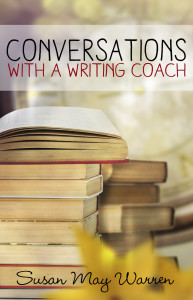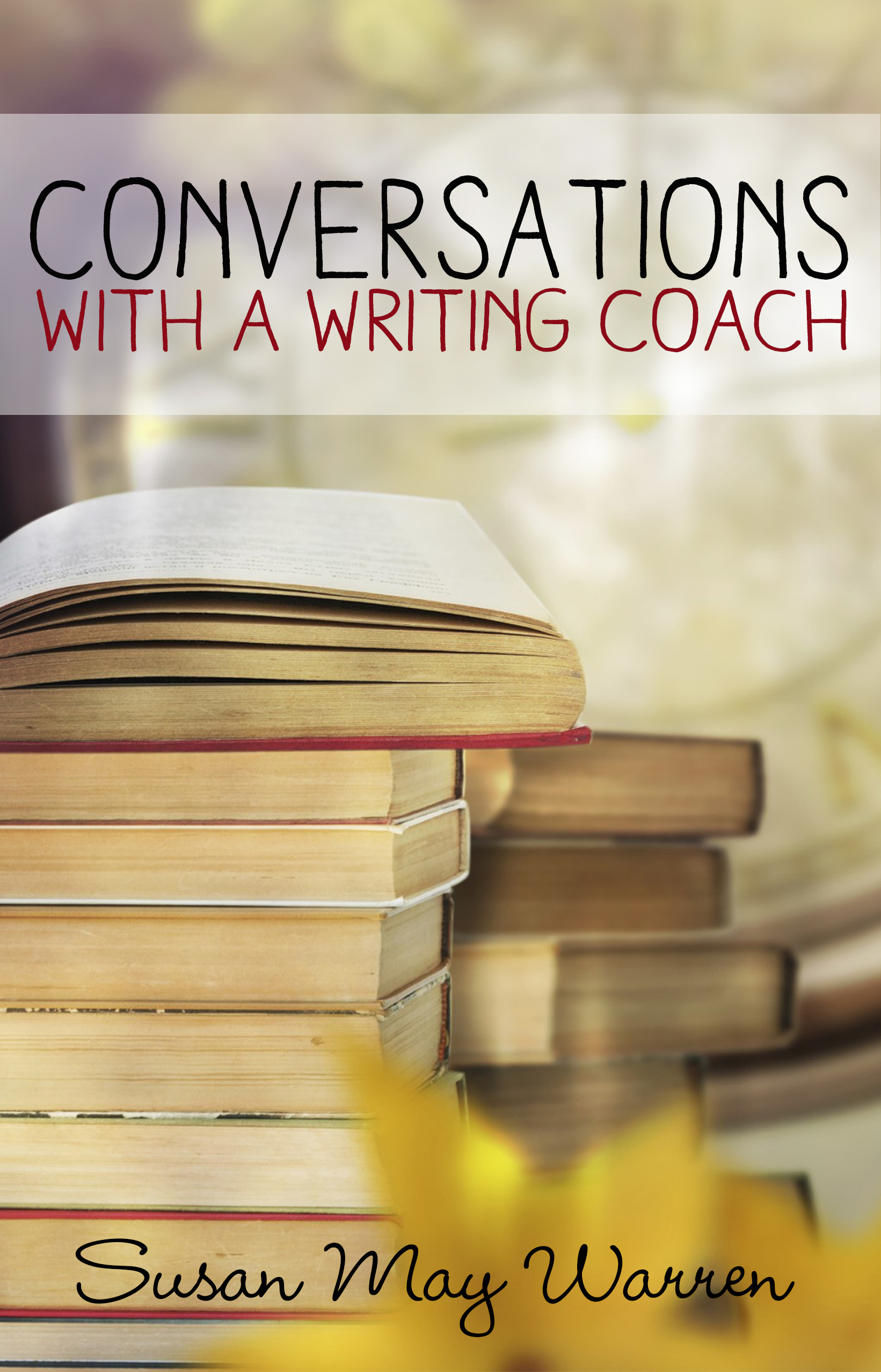If you want the entire Conversation on How to Write a Novel, check out Conversations with a Writing Coach!]
*****
“How is your NaNoWriMo manuscript going?” I set my coffee down at the table where Sally sat waiting for me, drinking coffee and eating a cookie. A light frost tipped the grass outside, the lake frothy along the rocky shoreline.
“I think my brain is shutting down. I’ve written about two thousand words a day, but I am running out of ideas on how to start my scene.” Sally broke off a piece of her monster cookie, the fresh-baked smell enough to make me wish I hadn’t eaten breakfast.
“Have you done your scene preparation? Figured out Layer One: what kind of scene it is, and the 5 Ws’?”
“Oh, that’s the easy part. And Layer Two isn’t so hard either. Creating Tension is easy once you understand the equation: a Character we care about who has a goal, as well as something to lose who meets obstacles that feel insurmountable so much so that we fear they’ll fail.”
“Right. The equation is: Sympathetic Character + Stakes + Goals + Obstacles + Fear of Failure.”
She broke off another piece of cookie. A M&M dropped onto her napkin. “But finding the first line and getting going that is stumping me. I feel like the words should just come to me, but…I’m staring at the blank page.”
“I understand. Let me teach you my first line/hook technique that is simple and fast to get you going into the scene. This is Layer Three and it’s simply about making the Hook SHARP.
“S stands for STAKES. What does your character have to lose? What can go wrong? You must have this element or there is simply no reason to have this scene, and especially no reason for your reader to stick with the story. In an Action scene, it’s something that could happen. In a ReAction scene, it might be making a bad decision. To find this, ask: What is the worst thing that could happen to your character right now? What does he/she fear?
“H stands for Hero/Heroine Identification. Why should we care about your character? What about your character makes us understand or even sympathize with him? To find that element ask: What do I have in common with my character? What need, or dream, or situation, or fear, or past experience do we share? And what about that can I extrapolate that fits into my story? Giving your character a realistic, sympathetic situation and realistic emotions is the key to creating that connection between your reader and your character.
“A stand for Anchoring, or Storyworld. Use your inner journalist to create place. By the end of the first paragraph, and for sure the first scene, you should have anchored your character into the scene by using the five W’s. Who, What, Where, When and Why? Then, add in the 5 senses. The Facts and Feelings work together to establish place and evoke emotions. The right storyworld can give us a feeling of happiness, or tension, even doom in the scene. Ask: What is the one emotion you’d like to establish in this first sentence, paragraph, scene? Using the five 5’s, what words can you find that conveys this sense of emotion? Use these in the crafting of your first paragraph.
“R reminds us to start your scene: on the Run. Writing craft instructor Dwight Swain in Techniques of the selling writer says that “a good story being in the middle, retrieves the past and continues to the end.” Your scene should start in the middle of the action, as if drawing back the curtain on the scene to find it already in action on the stage. Ask: How can I start my scene with the characters already engaging the problem of the scene?
“P helps us to identify and weave in the Thematic Problem, or the Story Question, in the scene. You will have one story question, or thematic question that drives your book. This question permeates all the decisions your hero and/or heroine make throughout the story. Ask: What thematic question is my character grappling with in this scene? How can you weave in the theme, or some part of it?
“Once you have identified all these pieces, climb into your POV character’s “skin” (or head) and stand at the edge of the stage, looking at all the activity and ask: What am I (as the character) thinking right now? Not what am I thinking about, but what am I thinking?
“Use this sentence to start your character in the scene. You can change it later, but at this moment, you’ll be in your character’s skin and able to go forward in their POV and write the scene. (Because you’ll know the goals, stakes, obstacles and even the thematic problem they’ll struggle with in the scene).
“What if I get the wrong first line?”
“Sally, there’s no wrong first line. But at this point, you’re just trying to get words on the page. Try it – you’ll be surprised at how the words just start to flow out of you once you figure out these elements.”
“I don’t know. I like to let the scene just . . . flow out of me. Organic. Seat of the pants.”
I looked at her cookie as she finished it off. “When you make cookies, you use the same ingredients for almost every kind of cookie. Sugar. Flour. Eggs. Salt. Baking soda. However, have you ever started making cookies and realized you’ve run out of one of the ingredients? Suddenly you have to run to the store, and your baking is stalled.
“The same thing happens when you are creating a scene. First, you assemble your ingredients. If you skip this part, you don’t know what you’re missing and you’ll suddenly be stalled in your creation process. This way, you’re pulling your “scene ingredients” out of the cupboard (your head) before you start mixing it together. You’re still writing the scene “Seat of the Pants” but you’re using specific ingredients to help you build it. And since you’ve assembled them before hand, you can flow without having to stop and figure out what you’re missing.”
“You’ve been eyeing my cookie all morning haven’t you?”
Truth: Success with scene building and maximizing your writing session is about preparation and gathering your ingredients before you begin.
Dare: Do your prep work before you begin your writing session. An hour of planning will save you and hour of staring at an empty page!
Have a great writing week!
Go! Write Something Brilliant!
Susie May
 Let’s have a conversation about how to be a published author! (only $4.99 on Kindle!)
Let’s have a conversation about how to be a published author! (only $4.99 on Kindle!)
“I was so excited to see that Conversations with a Writing Coach contains the lessons and writing aids that took me from being an unpublished writer to published with a multi-book contract. Susan’s talent for teaching the craft of writing is phenomenal. The lessons are easy to understand and will help beginning writers understand and develop their characters, plots and settings. And not just beginning writers—the workbook is a great refresher course for me as I begin my 5th book in two years. Patricia Bradley, author of the Logan Point series”

